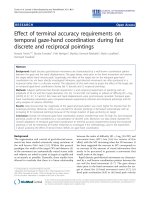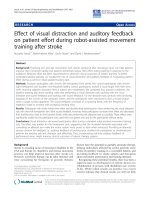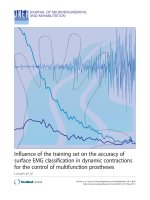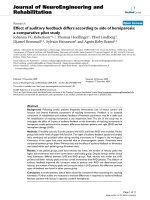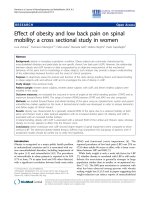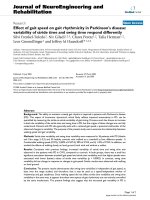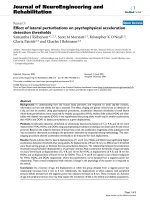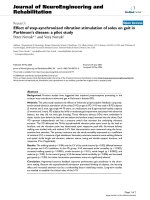Báo cáo hóa học: " Effect of terminal accuracy requirements on temporal gaze-hand coordination during fast discrete and reciprocal pointings" doc
Bạn đang xem bản rút gọn của tài liệu. Xem và tải ngay bản đầy đủ của tài liệu tại đây (638.43 KB, 12 trang )
RESEARCH Open Access
Effect of terminal accuracy requirements on
temporal gaze-hand coordination during fast
discrete and reciprocal pointings
Romain Terrier
1,2*
, Nicolas Forestier
1
, Félix Berrigan
3
, Mathieu Germain-Robitaille
2
, Martin Lavallière
2
,
Normand Teasdale
2
Abstract
Background: Rapid discrete goal-directed movements are characterized by a well known coordination pattern
between the gaze and the hand displacements. The gaze always starts prior to the hand movement and reaches
the target before hand velocity peak. Surprisingly, the effect of the target size on the temporal gaze-hand
coordination has not been directly investigated. Moreover, goal-directed movements are often produced in a
reciprocal rather than in a discrete manner. The objectives of this work were to assess the effect of the target size
on temporal gaze-hand coordination during fast 1) discrete and 2) reciprocal pointings.
Methods: Subjects performed fast discrete (experiment 1) and reciprocal (e xperiment 2) pointings with an
amplitude of 50 cm and four target diameters (7.6, 3.8, 1.9 and 0.95 cm) leading to indexes of difficulty (ID = log
2
[2A/D]) of 3.7, 4.7, 5.7 and 6.7 bits. Gaze and hand displacements were synchronously recorded. Temporal gaze-
hand coordination parameters were compared between experiments (discrete and reciprocal pointings) and IDs
using analyses of variance (ANOVAs).
Results: Data showed that the magnitude of the gaze-hand lead pattern was much higher for discrete than for
reciprocal pointings. Moreover, while it was constant for discrete pointings, it decreased systematically with an
increasing ID for reciprocal pointings because of the longer duration of gaze anchoring on target.
Conclusion: Overall, the temporal gaze-hand coordination analysis revealed that even for high IDs, fast reciprocal
pointings could not be considered as a concatenation of discrete units. Moreover, our data clearly illustrate the
smooth adaptation of temporal gaze-hand coordination to terminal accuracy requirements during fast reciprocal
pointings. It will be interesting for further researches to investigate if the methodology used in the experiment
2 allows assessing the effect of sensori-motor deficits on gaze-hand coordination.
Background
The organization and control of goal-directed move-
ments has been studied extensively using variations of
the well known Fitts’ task [1,2]. Within this general
paradigm, the width of the target (W) and distance (A)
of the movement are systematically varied across trials
and subjects are asked to point at targets as r apidly and
as accurately as possible. Generally, these studies have
allowed to c onclude that there is a linear relationship
between the index of difficulty (ID = Log
2
[2A/W]) and
movement time (MT) (see [3,4] for reviews of this
effect) with the MT increasing when the ID increases. It
has been suggested the increase in MT corresponds to
an increase of the amount of visual information that
needs to be processed to generate a movement that
would arrive at the target.
Rapid discrete goal-directed movements are chara cter-
ized by a well known coordination pattern between the
eye and the hand movement [5-7]. The gaze alway s
starts prior to the hand movement and reaches the tar-
get at about the (i) hand movement onset [5,7], (ii)
hand peak acceleration [8,9] or (iii) hand peak velocity
* Correspondence:
1
Laboratoire de Physiologie de l’Exercice (E.A. 4338), Département STAPS,
UFR CISM, Université de Savoie, 73376 Le Bourget du lac cedex, France
Full list of author information is available at the end of the article
Terrier et al. Journal of NeuroEngineering and Rehabilitation 2011, 8:10
/>JNER
JOURNAL OF NEUROENGINEERING
AND REHABILITATION
© 2011 Terr ier et al; licensee BioMed Central Ltd. This is an O pen Access article distri buted under the terms of the Creative Commons
Attribution License ( which permits unrestricted use, distributio n, and reproduction in
any medium, provided the original work is properly cited.
[10-12]. Generally, the gaze is in the vicinity of the tar-
get during hand deceleration. Such a gaze-hand lead
pattern is naturally assumed to allow (i) the early update
of the initial hand motor plan on the basis of acc urate
target location encoding [13-15] and (ii) the control of
the final phase of the movement on the basis of visual
information about relative target and hand locations
[9,16,17]. Surprisingly, the effect of the difficulty of the
task (and hence of the target size) on the temporal
gaze-hand coordination has not been directly investi-
gated. It is certainly of interest (for instance, from a
human factors perspective) to determine whether the
reported gaze-hand organization, considered as optimal,
is ID dependent.
Often, goal-directed movements are produced in a
reciprocal rather than in a discrete manner. For
instance, in the classical experiments of Paul Fitts, sub-
jects pointed back and forth between two targets as fast
and as accurately as possible for 20 sec. Despite the fact
the linear relationship between the ID and movement
time was first reported for reciprocal movements, there
has been an ongoing debate about 1) whether the units
of actions for d iscrete and reciprocal movements are
similar [18-21], and 2) whether the relationship between
the ID and mo vement time is linear [22]. For example,
Guiard [19,23] s howed that the deceleration phase of a
reciprocal pointing completely overlaps the reaccelera-
tion phase of the following pointing movement, taking
advantage of the stored elastic energy. Such a kinematic
organization, governed by a cyclical unit, is qualified as
harmonic (see [23] for details about harmonicity calcula-
tion) and Guiard [19] has a rgued this organization does
not support the suggestion that reciprocal movements
can be decomposed into discrete segments. This latter
interpretation, often labeled the concatenation hypoth-
esis, would imply a waste of this stored elastic energy
once every half-cycle. Nevertheless, there are several
examples where reciprocal pointings became inharmonic
when the target size was decreased and the ID increased
above a critical value included between 4.01 and
4.91 bits [23-25]. Recently, Huys et al. [22] also pre-
sented a demonstration that, for reciprocal movements,
the re lationship between ID and movement time is not
continuous and that different control mechanisms corre-
spond to low and high IDs with rhythmic movements
implemented in easy tasks and discrete movements in
difficult ones. This suggestion also has received support
from neuro-imaging research [26,27]. For instance,
Schaal et al. [26] reported that discrete wrist flexion and
extension movements activated more cortical areas than
rhythmic wrist movements. Specifically, more prefrontal
and parietal areas were involved in reaching and com-
plex sequential actions than for rhythmic movements,
suggesting that rhythmic movements are monitored by
an automatic control whereas more cognitive fun ctions
are required to control discrete movements.
As recently underlined by Lazzari et al. [28], the inves-
tigation of gaze-hand coordination during reciprocal
tasks has received little attention despite the fact that
for reciprocal movements, visual information is required
both to bring the movement in progress to a successful
conclusion and to prepare the next movement [29].
Hence, a trade-off has to be made between visual con-
trol of the final phase of the current movement and the
magnitude of the gaze-hand lead pattern for the upcom-
ing movement. Such a trade-off could potentially be
influenced by the accuracy requirements (ID). According
to Elliott et al. [30], when the accuracy requirements are
relatively low, accurate movements may be concluded
without visual information about relative target and
hand locations during the terminal phase. Formally, lar-
ger targets could allow subjects to determine that the
planned motor program (updated from accura te target
location encoding) does not require terminal correc-
tions. On the other hand, higher IDs would be asso-
ciated with additional visual processing co st relative to
the final phase of the preceding movement leading to a
decrease of the gaze-hand lead pattern magnitude.
Two experiments were designed to analyze the effect
of various IDs on the kinematics of the hand movement
and the temporal coordination between the gaze
and the hand. We examined the coordination of t he
gaze-hand lead pattern when fast discrete pointings and
reciprocal pointings to four different target sizes were
produced. Our results show a stable and fixed gaze-
hand lead pattern for discrete pointings. For reciprocal
pointings, the gaze-hand lead pattern was much small er
and decreased line arly with an increased target size. We
discuss the ro le of t his differential control mechanis m
for discrete and reciprocal movements.
Experiment 1: discrete pointing
Methods
Subjects
6 right handed males (mean age : 27 ± 3.8 yrs, mean
height : 181 ± 5.5 cm, and mean weight: 77 ± 9.2 kg)
without any history of joint or neuromuscular disease
took part in this experiment on a voluntary basis. They
were naïve as to the purposes of the experiment. All
part icipants gave their written informed consent to par-
ticipate in this study, which was approved by the Laval
University Ethic Committee.
Task and apparatus
As illustrated in figure 1, participants were seated in
front of a vertical board with two aluminum circular tar-
gets. The distance between subjects’ forehe ad and the
board was approximately 60 cm. The center of the
lower target (T1) was about at the height corresponding
Terrier et al. Journal of NeuroEngineering and Rehabilitation 2011, 8:10
/>Page 2 of 12
to the subjects’ inter-acromial line. The upper target
(T2) was sh ifted 35 cm to the right and to the top lead-
ing to a mplitude (A) of 50 cm between targets. Thus,
the horizontal and vertical amplitudes of gaze displace-
ments necessary to focus on e ach target’s center were
about 32°. A Fitts-like paradigm (Fitts 1954) with four
pairs of targets (diameter (D) of 7.6, 3.8, 1.9 and
0.95 cm; thickness : 2.5 cm) was used for the pointing
trials. This setup allowed indic es of difficulty ( ID = log
2
[2A/D]) of 3.7, 4.7, 5.7 and 6.7 bits. Pointing movements
were made with a stylus having a 1-mm tip. The targets
and the stylus were electrically connected allowing
detection of when subjects left the lower target and
reached the upper one. This volt age signal was recorded
at 1200 Hz (12-bit A/D conversion). Moreover, the 3D
kinematics of the effectors movement was sampled at
120 Hz by means of a magnetic receiver (Polhemus™
Liberty) fixed on the stylus.
The eye and head movements were recorded with a
head mounted eye tracker (Applied Sciences Labora-
tories model H6). The eye camera and inf ra-red illumi-
nator enabled tracking the left eye pupil and corneal
reflection with a real-time delay of 25 ms. A calibration
procedure specific to each subject allowed determining
the eye-in-head positi on within a 45° (horizontal) by 35°
(vertical) visual field. A magnetic receiver (Flock of
Birds Ascension Technology) fixed on the eye tracker
head band recorded t he head position and orientation in
space. Finally, the eye tracker system i ntegrated the eye-
in-head and head-in-space positions, both sampled at
Figure 1 Schematic of the experimental set up. See the text for more details.
Terrier et al. Journal of NeuroEngineering and Rehabilitation 2011, 8:10
/>Page 3 of 12
120 Hz, to compute the point of gaze coordinates on
the vertical board plane.
All data (target contacts, kinematics of the stylus, and
point of gaze coordinates) were synchronized on the
external sync TTL signal of the Polhemus Liberty by
means of a microcontroller (Parallax, Basic Stamp).
Procedure
For each of the four IDs, subjects p erformed a block of
ten discrete pointing trials from the lower (T1) to the
upper (T2) target. The order of presentation was rando-
mized between subjects. They were instructed to point
as quickly and accurately as possible. Each trial started
with the stylus and the point of gaze on the lower tar-
get. A verbal signal given by the experimenter was the
stimulus to move. A trial was accepted when the subject
hit the target without any contact with the surrounding
board. The targets’ thickness (2.5 cm) precluded subjects
from gliding between the vertical board and the stylus.
Subjects were not allowed more than 2 errors per block.
When this occurred, a new condition was presented and
the complete block of 10 trials was presented again at
the end of the session. To prevent fatigue, a short rest
was allowed be tween each trial and each block. Bef ore
data recording, subjects performed several discrete
pointing trials until they feel comfortable and efficient
for the different IDs.
Data analysis
The electrical contacts between the stylus and the tar-
gets were used to determine t he start and the end of
each pointing trial. The duration between the end of the
lower target contact and the onset of the upper target
contact was defined as the hand movement time (MT).
Position data from the stylus were filtered (Butter-
worth fourth-order with a 7 Hz low pass cut-off fre-
quency with dual-pass to remove phase shift) prior to
calculation of the hand resultant velocity (finite-differ-
ence algorithm). Velocity peaks were dete rmined with
custom software developed in Matlab™.Theduration
between the onset of a pointing and its peak speed
defined the duration of the acceleration phase while the
time between the peak speed and the end of the point-
ing defined the duration of the deceleration phase.
The onset of gaze displa cement for each pointing was
determined from the resultant velocity in the vertical
planeusingathresholdof1m.s
-1
[31]. The ONSET
latency, defined as the difference between the onset of
the gaze displacement and that of the hand was then
calculated as follows:
ONSET latency onset of the hand onset of the gaze .
A positive value indicates the gaze displacement was
initiated prior to the hand movement whereas a negative
value indicates the gaze was initiated after the hand
movement.
All dependent variables were submitted to one-way
repeated measures ANOVA (4 IDs ). A .05 alpha thresh-
old was adopted throughout. When significant, the main
effect of ID was decomposed with a linear trend
analysis.
Results
Hand movements characteristics
Table 1 presents a summary of the results for the dis-
crete pointings. Overall, we recorded 14 errors and only
2 blocks were retaken. Movement time, the duration of
acceleration and deceleration phases all increased with
an increasing ID while hand peak speed decreased. Post-
hoc analyses showed that the increase was linear for
MT, and the deceleration phase duration; the decrease
was linear for the hand peak speed (linear trends ana-
lyses: F(1,5) = 126.6, p < 0.01; F(1,5) = 99.3, p < 0.01; F
(1,5) = 25.45, p < 0.01, respectively). For the acceleration
phase duration, the linear trend was not significant (F
(1,5) = 4.75, p > 0.05) but the durations for the two
smaller IDs were smaller than those for the two larger
IDs (ps < 0.05) The deceleration phase duration
expressed in percentage of the movement time increased
significantly with an increasing ID, illustrating that hand
movements became less symmetric when the ID
increased. On average, for the lower and higher ID, the
deceleration phase duration represented 59% and 79% of
the movement time, respectively.
Gaze-hand coordination
All ONSET latencies were positive indicating that gaze
displacement was initiated systematically prior to the
hand movement. The main effect of ID was not s ignifi-
cant (F(3,15) = 0.12, p = 0.95) and the mean ONSET
latency was 145 ms.
Discussion
As stipulated by Fitts’ law, MT for discrete pointings
increased linearly with an increasing ID. A more
detailed analysis of the hand responses (see Table 1)
revealed that the increased MT resulted mostl y from an
increased duration of the deceleration phase. As
reported by several authors (e.g. [3, 32]), this presumably
results from an increased reliance u pon visual feedback
control processes for the most difficult IDs.
Varying the size of the target did not modify the
ONSET latency and the gaze was initiated, on average,
145 ms prior to the onset of the hand movement. This
confirms previous observations with various aiming and
pointing tasks (e.g. [5,7-9,33]). Figure 2 shows gaze and
hand velocity pr ofiles from one rep resentative subject,
forthelower(2A)andthehigher(2B)IDs.Thesedata
illustrate that ONSET latency was stable and that gaze
was anchored on the target before the hand peak velo-
city. As men tion ed above, this sequence allows both (i)
Terrier et al. Journal of NeuroEngineering and Rehabilitation 2011, 8:10
/>Page 4 of 12
the early update of the i nitial hand moto r plan on the
basis of an accurate encoding of the target location
[13-15] and (i i) an accurate control of the final phase of
the p ointing movement on the basis of visual informa-
tion about relative target and hand locations [9,16].
The second experiment examine s if this fixed o rgani-
zation remains when reciprocal pointings are performed.
As mentioned in the introduction there has been an
ongoing debate as to whether the units of actions for
discrete and reciprocal movements are similar
[18-21,23]. If reciprocal pointings for higher IDs are a
succession of real discrete units, a similar and stable
gaze-hand lead pattern should be observed even when
pointing to smaller targets and this gaze-hand pattern
should resembled that observed for discrete movements.
If this is the case, an increased visual processing relative
to the final phase of the preceding movement could be
associated with a gaze-hand lead magnitude stabilization
by means of a dwell time increase [24,34,35].
Experiment 2: reciprocal pointings
Methods
Subjects
12 right handed males (mean age: 25.2 ± 4.7 yrs, mean
height: 179.6 ± 6.5 cm, and mean weight: 75.6 ± 8.2 kg)
took part in this study. Six of them also participated in
experiment 1. As for experiment 1, they were without
any history of joint or neuromuscular disease and they
took part in the experiment on a voluntary basis. They
were all naïve as to the specific purposes of the experi-
ment. All participants gave their written informed con-
sent to participate in this study, which was approved by
the Laval University Ethics Committee.
Task and apparatus
The same experimental set-up was used and the two
studies were differentiated only by the nature of the
pointing task: discrete pointings in experiment 1 and
reciprocal pointings in this second experiment.
Procedure
For each ID, the task was to alternatively point at the tar-
gets as qu ic kly and as ac cura tely as possible during a 25 sec-
onds trial. As the error level cannot easily be controlled
online during reciprocal pointings, a ratio of unsuccessful/
successful contacts was calculated a posteriori. No more
instructionwasgiveninorder to record the subjects ’
visuo-motor organizations under unconstrained conditions.
Before data recording, subjects performed practice trials
until they felt comfortable and efficient for the different
IDs. During data recording, the order of presentation of
the four targets (IDs) was randomized between subjects.
Each trial started with the stylus and the point of gaze on
the lower target. To prevent fatigue, a short rest was
allowed between trials and target conditions.
Data analysis
As for experiment 1, the contact sig nals and hand displa-
cement data were processed to compute Movement Time
(MT), hand peak velocity, and duration of the acceleration
and deceleration phases. All trials were vi sually inspected
by comparing contact signals to hand displacement sig-
nals. When a hand reversal displacement (as observed
from the displacement signals from the magnetic tracker)
was not associated with a target contact, the pointing was
considered as unsuccessful. To determine pointing accu-
racy, the ratio of unsuccessful pointings (without target
contact) to the total number of pointings was calculated
for each 25-s trial. Moreover, the contact time (CT),
defined as the time between the onset and the end of the
same target contact, was also computed.
The tempo ral gaze-hand coordination was analyzed by
computing the ONSET latency with the same methodol-
ogy than for the first experiment. To avoid the analysis of
initial responses starting from a static position and the
last responses where subjects may have anticipated the
end of the 25-s period, the gaze r esponses for the first
ten successful pointings (with target contact) between
the 7th and 18th second were analysed. Moreover, a sup-
plementary variable (OFFSET latency) specific to recipro-
cal pointings also was computed. The OFFSET latency
was defined as the difference between the end of the
hand movement (n) and the onset of the gaze for the fol-
lowing movement (n + 1). It was calculated as follows:
OFFSET latency end of hand movement onset of gaze n 1 () (n –))
A positive va lue indicates the gaze moved on to the
next target before completion of the preceding pointi ng
whereas a negative value indicates the gaze still focused
Table 1 Effects of ID on temporal parameters of hand movements during discrete pointing
Temporal parameters ID values Effect of ID
3.7 4.7 5.7 6.7 F(3,15)
Movement time (ms) 276 (±36) 335 (±36) 512 (±47) 651 (±69) 92.9 ***
Duration of acceleration phase (ms) 113 (±17) 114 (±8) 133 (±12) 134 (±16) 4.4 *
Duration of deceleration phase (ms) 163 (±33) 221 (±31) 379 (±48) 517 (±72) 74.8 ***
Duration of deceleration phase (%MT) 59 (±6) 65.5 (±2.5) 74 (±3) 79 (±3.5) 26.8 ***
Hand velocity peak (m.s
-1
) 2.93 (±0.34) 2.60 (±0.14) 2.30 (±0.12) 2.19 (±0.11) 16.7 ***
*** P < 0.001; * P < 0.05.
Terrier et al. Journal of NeuroEngineering and Rehabilitation 2011, 8:10
/>Page 5 of 12
on the currently aimed target when the hand made con-
tact with the target. Figure 3 illustrates how ONSET
and OFFSET latencies were computed.
All dependent variables were submitted to on e-way
repeated measures ANOVA (4 IDs). Furthermore, for
the 6 subjects who performed the two experiments, a
specific 2 Conditions (discrete and reciprocal pointings)
× 4 IDs (3.7, 4.7, 5.7 and 6.7 bits) ANOVA wit h
repeated-measures on both factors was performed on
ONSET gaze-hand latency. A .05 alpha threshold was
Figure 2 Typical data of one representative subject for discrete pointing trials.(A) 3.7 bits ID condition. (B) 6.7 bits ID condition. Blue lines
represent gaze velocity profiles whereas black lines represent hand velocity profiles. Note that ONSET latency was stable across ID conditions and
that gaze was anchored on target before hand velocity peak.
Terrier et al. Journal of NeuroEngineering and Rehabilitation 2011, 8:10
/>Page 6 of 12
adopted throughout. When significant, the main effect
of ID was decomposed with a linear trend analysis.
Results
Hand movement characteristics
The percentage of unsuccessful pointings increased sig-
nificantly with an increasing ID but values remained rela-
tively low (on average, 1.9, 3.0, 7.1 and 7.0% for IDs of
3.7, 4.7, 5.7 and 6.7 bits, respectively; F(3,33) = 4.18, p <
0.01). A comparison of means (Tukey) showed the per-
centages were not dif ferent for the two lower IDs ( p >
0.05) and that percentages for the two higher IDs were
greater than those observed for the smaller IDs ( p <
0.05). Table 2 presents a summary of the results for the
pointings analyzed. As for discrete pointings, the main
effect of ID was significant for all var iables analysed. MT
increased linearly with an increas ing ID (F(1,11) = 159.1,
p < 0.01 for the linear trend). Both the duration of the
acceleration and deceleration phases also increased line-
arly with an increasing ID (F(1,11) = 144.4, p <0.01and
F(1,11) = 207.2, p < 0.01, resp ectively) and the hand peak
speed decreased linearly with an increasing ID (F(1,11) =
68.2, p < 0.01). Moreover, the deceleration phase dura-
tion expressed in percentage of the movement time
increased significantly with an increasing ID, illustrating
that hand movements became less symmetric. On aver-
age, the deceleration phase duration represented 54% and
67% of the movement time, for the lower and higher ID
respectively. Finally, the duration of the contact with the
targe ts (or dwell time) increased linearly with an increas-
ing ID (F(1,11) = 50.8, p < 0.01). However, this increase
of 27 ms from the lower to the higher ID was small.
Temporal gaze-hand coordination
ONSET latency during reciprocal p ointings (12 sub-
jects) Figure 4 presents the average ONSET latency for
the four IDs during the reciprocal pointing. All ONSET
latencies were positive indicating that gaze displacements
were systematically initiated prior to hand movements.
The ANOVA revealed a significant effect of ID (F(3,33) =
42.64, p < 0 .01) and, as illustrated in figure 4, the mean
ONSET latency decreased linearly with an increasing ID
(F(1,11) = 114.8, p < 0.01 for the linear trend). This also
indicates the magnitude of gaze-hand lead pattern was
reduced when the difficulty of the task (ID) increased
and it was nearly abolished for the most difficult ID. A t-
test showed the ONSET latencies for the 6.7 bits ID were
not different from 0 (t(11) = 1.02, p > 0.05) suggesting
the gaze and hand were nearly sync hronous. This modifi-
cation of the temporal gaze-hand coordination is illu-
strated in figures 5A and 5C. Figure 5A presents gaze
Figure 3 Illustration of the methodological approach to compute ONSET and OFFSET latencies. The black line represents the contacts
between the stylus and the targets. The grey line represents resultant gaze velocity in the vertical plane. Numerical marks are defined as follows:
1 = onset of gaze saccade; 2 = end of the preceding hand movement; 3 = onset of the considered hand movement. Note that OFFSET latency
of the movement n-1 is positive (saccade n began before the end of movement n-1) whereas the OFFSET latency of the movement n is
negative (saccade n + 1 began after the end of movement n). It can also be observed that ONSET latency for movement n is longer than
ONSET latency for movement n + 1.
Terrier et al. Journal of NeuroEngineering and Rehabilitation 2011, 8:10
/>Page 7 of 12
(blue solid line) and hand (black d ashed line) velocity
profiles for 6 pointings for the lower ID (3.7 bits) condi-
tion. Gaze onset times precede hand onset times, corre-
sponding to positive ONSET latencies. For example, the
first gaze onset time (G1, blue solid arrow) precedes the
firsthandonsettime(H1,blackdashedarrow).Figure
5C presents gaze (blue solid line) and hand (black dashed
line) velocity profiles f or 3 pointings for the higher ID
(6.7 bits) condition. Gaze and hand onset times are nearly
synchronous. For example, the first gaze onset time (G1,
blue soli d arrow) occurs only few milliseconds before the
first hand onset time (H1, black dashed arrow).
OFFSET latency during reciproc al pointings (12 sub-
jects) As shown in figure 4, the OFFSET latency also
decreased with an increasing ID. The ANOVA showed a
significant effect of ID on OFFSET latency (F(3,33) =
51, p < 0.01) and the linear trend wa s significant (F
(1,11) = 154.5, p < 0.01). The OFFSET latencies were
positive for the ID of 3.7, indicating that subjects moved
their gaze on to the next target before completing the
preceding movement. However, for higher IDs, subjects
still fixated the aimed target at the c ontact time, as
revealed by the negative values of OFFSET late ncy. As
the ID increased, subjects increased the duration of the
fixation on the target. This diff erential gaze-hand orga-
nization is well illustrated by representative data dis-
played on figures 5B and 5D showing gaze velocity
profiles (blue solid lines) and targets contacts (dark
square-like signals). The beginning of a target contact
corresponds to the end of a hand movement whereas
Table 2 Effects of ID on temporal parameters of hand movements during reciprocal pointing
Temporal parameters ID values Effect of ID
3.7 4.7 5.7 6.7 F(3,33)
Movement time (ms) 299 (±50) 374 (±52) 508 (±69) 701 (±120) 118.2 ***
Duration of acceleration phase (ms) 136 (±30) 157 (±27) 200 (±27) 231 (±31) 106.6 ***
Duration of deceleration phase (ms) 163 (±31) 217 (±39) 308 (±49) 470 (±90) 133 ***
Duration of deceleration phase (%MT) 54 (±5.5) 58 (±5) 61 (±4) 67 (±5.5) 43.5 ***
Hand velocity peak (m.s
-1
) 2.55 (±0.24) 2.23 (±0.25) 1.95 (±0.20) 1.86 (±0.27) 35.8 ***
Contact time (ms) 50 (±12) 53 (±8) 66 (±15) 77 (±19) 22.5 ***
*** P < 0.001.
Figure 4 Illustration of the effect of ID on ONSET and OFFSET latencies for reciprocal pointing trials.BlacksquaresrepresentONSET
latency whereas grey triangles represent OFFSET latency for the 12 subjects who performed the experiment 2. Error bars represent the standard
deviation. Note that ONSET and OFFSET latencies significantly decreased with an increasing ID.
Terrier et al. Journal of NeuroEngineering and Rehabilitation 2011, 8:10
/>Page 8 of 12
the end of a target contact r epresents the beginning of
the following hand moveme nt. Figure 5B s hows positive
OFFSET latencies associated with the smaller ID: for
most pointi ngs, the gaze displacement begins before the
end of the preceding hand mov ement. For example, the
onset time of the first gaze displacement (G1, blue solid
arrow) occurs before the end of the preceding hand
movement (black solid arrow). Figure 5D shows negative
OFFSET latencies associated with the higher ID: gaze
displacements usually begin after the end of the preced-
ing hand movement. For example, the first gaze displa-
cement (G1, b lue solid ar row) begins aft er the end of
the pre ceding hand movement (black solid arrow). Thi s
is observed for all three gaze responses illustrated.
Discrete vs reciprocal pointings (6 subjects)
The ONSET latencies for the 6 subjects who partici-
pated to both experiments (discrete and reciprocal
pointings) were compared to directly assess differences
Figure 5 Typical data of one representative subject for reciprocal pointing trials. A and B: lower ID (3.7 bits). Figure 5A presents gaze
(blue solid line) and hand (black dashed line) velocity profiles. The blue solid arrow represents gaze onset time and the black dashed arrow
represents hand onset time for the same pointing. Figure 5B presents gaze velocity and targets contacts (dark square-like signals) for the same
pointings. The blue solid arrow represents gaze onset time and the black solid arrow represents the end of the preceding hand movement. C
and D: higher ID (6.7 bits). Figure 5C presents gaze (blue solid line) and hand (black dashed line) velocity profiles. The blue solid arrow
represents gaze onset time and the black dashed arrow represents hand onset time for the same pointing. Figure 5D presents gaze velocity and
targets contacts (dark square-like signals) for the same pointings. The blue solid arrow represents gaze onset time and the black solid arrow
represents the end of the preceding hand movement. See the text for more details.
Terrier et al. Journal of NeuroEngineering and Rehabilitation 2011, 8:10
/>Page 9 of 12
in temporal gaze-hand coordination between discrete
and reciprocal pointings. As illustrated in figure 6, the
comparison of ONSET latencies obtained during exper i-
ment 1 (discrete pointing task) and 2 (reciprocal point-
ing task) revealed a significant main effect of Task (F
(1,5) = 19.23, p < 0.01) showing t hat ONSET latencies
were globally higher for the discrete pointing task than
for the reciprocal task. The ANOVA also showed a sig-
nificant interaction of Task × ID (F(3,15) = 5.35, p <
0.05) illustrating that, while the gaze-hand lead pattern
was constant for all IDs for discrete pointings, the
ONSET latency was smaller for reciprocal pointings and
it decreased with an increasing I D. The ONSET latency
was almost zero for the 6.7 bits conditions. These
changes in the gaze-hand coordination suggest that,
from a visuo-manual viewpoint , fast reciprocal pointings
under high IDs conditions could not be consi dered as a
concatenation of discrete units.
Discussion
The a posteriori analysis of the errors showed a signif i-
cant effect of ID on the ratio of unsuccessful trials. This
ratio was small (less than 2%) when accuracy constraints
were smaller (3.7 bits) and it increased somewhat (up to
7%) when accuracy constraints increased (6.7 bits).
Despite this small decrease in the accuracy, as stipulated
by Fitts’ law, MT still increased linearly as a function of
the increasing ID sugge sting that subjects respected
both the speed and the accuracy instructions. The
increased MT resulted most ly but not exclusively from
an increase d duration of the decele ration pha se.
Expressed in percentage of movement time, this increase
shows that ha nd movement kinematics became less
symmetric with an increasing ID. In addition, a small
but significant increase of dwell times was observed
with an increasing ID ( on average, 27 ms from the
lower to the higher ID).
This small increase in dwell time did not lead to con-
stant and stable gaze-hand coordination. With increas-
ing ID, significant and grad ual changes were observed in
the gaze-hand coordination. From a visuo-man ual view-
point, none of the patterns resembled that observed for
discrete movements suggesting that reciprocal pointings
were not a concatenation of discrete units at any of the
ID examined. Specifically, the temporal analysis of the
gaze-hand coordination revealed that the OFFSET
latency decreased when the ID increased. The mean
OFFSET latency was small but positive for the 3.7 bits
ID (about 20 ms) whereas it was negative for the
6.7 bits ID (about -60 ms). Hence, this indicates the
gaze moved to the next target before co mpletion of the
preceding movement when the ID wa s small whereas
Figure 6 Illustration of the effect of ID on ONSET latencies for discrete and reciprocal pointings. Data from the 6 subjects who
performed the two experiments, i.e. discrete and reciprocal pointings are presented. The solid line represents discrete pointing whereas the
dashed line represents reciprocal pointing. Error bars represent the standard deviation. Note (i) that ID affects ONSET latency for reciprocal but
not for discrete pointing (ii) and that values are significantly higher for discrete than for reciprocal pointing for all IDs.
Terrier et al. Journal of NeuroEngineering and Rehabilitation 2011, 8:10
/>Page 10 of 12
subjects still focused on the aimed target at the contact
time for higher IDs. The positive OFFSET latency asso-
ciated with the smaller ID is consistent with previous
observations showing that visual information about the
final phase is not necessary to conclude movements
towards large targets [ 30,36,37]. The negative OFFSET
latencies associated with higher IDs suggest that visual
feedback from both hand and target during movement
termination was necessary for coping with the increased
accuracy requirements. Such a result is in line with the
data reported by Neggers and Bekkering [6,38] for dis-
crete movements showing that gaze of ten is anchored o n
the aimed target until movement completion. This was
also observed in experiment 1, as illustrated in figure 2.
NeggersandBekkering[6]showedthatanchoringwas
present even without vision of the moving limb suggest-
ing the mechanism is based either on an internal signal
or a proprioceptive signal. The small increase of contact
time from lower to higher ID (on average, 27 ms) was
not sufficient to compensate for the increasing visually-
based control of the final movement stage and planning
of the upcoming movement. As a result, the ONSET
latency decreased significantly with an increasing ID indi-
cating that the magnitude of the gaze-hand lead pattern
was reduced when the target size decreased. On average,
the gaze onset preceded the hand onset by about 70 ms
for the 3.7 bits ID whereas gaze and hand onsets
occurred nearly simultaneously for the 6.7 bits ID.
Interestingly, this gaze and hand onset times synchro-
nization is not in agreement with the classical gaze-
hand lead pattern reported for discrete pointings
[5,8-11] which was also observed in experiment 1 with
discrete pointings. Data from the 6 su bjects who partici-
pated to both experiments allowed a direct comparison
of ONSET latencies for discrete and reciprocal point-
ings. First, the magnitude of the gaze-hand lead pattern
was much higher for discrete than for reciprocal point-
ings. Second, while it was constant for discrete point-
ings, it decreased systematically with an increasing ID
for reciprocal pointings (nearly simultaneous onset for
thegazeandhandforthe6.7bitsID).Theseobserva-
tions, at least from a visuo-manual viewpoint, clearly
suggest that rapid reciprocal pointings cannot be consid-
ered as a succession of discrete movements. This also
agrees with recent observations by Huys et al. [22]
about reciprocal movements. Thes e authors have argued
that Fitts’ law is discontinuous in reciprocal aiming.
They suggested a transition in the control mechanisms
with increasing task difficulty, with rhythmic movements
implemented in easy tasks and discrete movements in
difficult ones. Our data also favors this interpretation.
There is a possibility that for lower IDs, an intermittent
mode of c ontrol was adopte d. Such a mode certainly is
reminiscent of the occasional executive monitoring
proposed by Pew [39] more than four decades ago. As
the task difficulty increases, an increased visual control
over the terminal phase of the movement is observed. It
is this increased reliance upon vi sual control that leads
to a transition in the control mechanism. The d isconti-
nuity observed as the task difficulty increases, however,
is not a concatenation of discrete units observed when
discrete movements only are planned and controlled.
The dual role of vision in reciprocal movements (control
of the terminal phase and planning of the upcoming
movement) appears to impose additional constraints
that are not implemented simply by increasing the dwell
time. The more rapid gaze response still allows the gaze
to be in the vicinity of the target as the hand approaches
it. Lazzari et al. [28] recently observed t hat eye-hand
synchronization swit ched from intermittent control for
larger targets to continuous monitoring for small tar-
gets. The temporal analysis reported here shows a more
progressive adaptation of the gaze-hand coordination as
a function of the endpoint accuracy requirements.
Conclusion
The aim of this work was to determine whether accu-
racy constrai nts altered the gaze-hand coordination pat-
tern when producing discrete or reciprocal pointings.
For discrete pointings, a robust and stable temporal
visuo-manual coordination was observed with the gaze
leading the hand by about 145 ms. When performing
fast reciprocal pointings, the duration of the gaze
anchoring on the target increased by approximately
85 ms from the lower to the higher ID and the contact
duration (or dwell time) increased, on average by only
27 ms. As a consequence, the magnitude of the gaze-
hand lead pattern decreased and it was nearly abolished
for the higher ID (6.7 bits). Overall, the temporal gaze-
hand coordination analysis revealed that even for high
IDs, fast reciprocal pointings could not be considered as
a concatenation of discrete units.
Finally, our data c learly illustrate the smooth adapta-
tion of temporal gaze-hand coordination to contextual
parameters such as terminal accuracy requirements dur-
ing fast reciprocal pointings. It will be interesting for
further researches to investigate if the methodology
used in the experiment 2 allows assessing the effect of
sensori-motor deficits on gaze-hand coordination. In the
future, such a procedure may be used to accurately
assess visuo-motor deficits i n patients suffering from
pathologies such as Parkinson’ s disease [40], cerebral
palsy [41] or traumatic brain injuries [42], known to
impair visuo-motor coordination.
Acknowledgements
The study was supported in part by a mobility grant from the Région
Rhône-Alpes, France (RT) and a NSERC grant (NT). Special thanks to Marcel
Terrier et al. Journal of NeuroEngineering and Rehabilitation 2011, 8:10
/>Page 11 of 12
Kaszap for programming and technical expertise and to Grant Handrigan for
his help in ironing out last minute English language problems. We also
thank all the subjects for their cooperation.
Author details
1
Laboratoire de Physiologie de l’Exercice (E.A. 4338), Département STAPS,
UFR CISM, Université de Savoie, 73376 Le Bourget du lac cedex, France.
2
Groupe de Recherche en Analyse du Mouvement et Ergonomie, Division de
Kinésiologie, Département de Médecine Sociale et Préventive, Faculté de
Médecine, Université Laval, Québec (Québec), G1K 7P4, Canada.
3
Faculté
d’éducation physique et sportive, Université de Sherbrooke, Sherbrooke
(Québec), J1K 2R1, Canada.
Authors’ contributions
RT, NF and NT conceived the study. RT recruited subjects, performed data
acquisition and analysis and drafting of the manuscript. NF and NT
evaluated the data and participated to the manuscript writing. FB, MGR and
ML participated to data acquisition and analysis. All authors read and
approved the final manuscript.
Competing interests
The authors declare that they have no competing interests.
Received: 24 April 2010 Accepted: 14 February 2011
Published: 14 February 2011
References
1. Fitts PM: The information capacity of the human motor system in
controlling the amplitude of movement. J Exp Psychol 1954, 47:381-391.
2. Fitts PM, Peterson JR: Information capacity of discrete motor responses.
J Exp Psychol 1964, 67:103-112.
3. Plamondon R, Alimi AM: Speed/accuracy trade-offs in target-directed
movements. Behav Brain Sci 1997, 20:279-303, discussion 303-349.
4. Schmidt RA, Lee T: Motor Control and Learning: A Behavioral Emphasis,
fourth edition Human Kinetics; 2005.
5. Goodale MA, Pelisson D, Prablanc C: Large adjustments in visually guided
reaching do not depend on vision of the hand or perception of target
displacement. Nature 1986, 320:748-750.
6. Neggers SF, Bekkering H: Gaze anchoring to a pointing target is present
during the entire pointing movement and is driven by a non-visual
signal. J Neurophysiol 2001, 86:961-970.
7. Prablanc C, Martin O: Automatic control during hand reaching at
undetected two-dimensional target displacements. J Neurophysiol 1992,
67:455-469.
8. Helsen W, Starkes JL, Elliott D, Ricker KL: Temporal and spatial coupling of
point of gaze and hand movements in aiming. J Mot Behav 1998, 30:249-259.
9. Helsen WF, Elliott D, Starkes JL, Ricker KL: Coupling of eye, finger, elbow,
and shoulder movements during manual aiming. J Mot Behav 2000,
32:241-248.
10. Abrams RA, Meyer DE, Kornblum S: Eye-hand coordination: oculomotor
control in rapid aimed limb movements. J Exp Psychol Hum Percept
Perform 1990, 16:248-267.
11. Binsted G, Chua R, Helsen W, Elliott D: Eye-hand coordination in goal-
directed aiming. Hum Mov Sci 2001, 20:563-585.
12. Feys P, Helsen WF, Liu X, Nuttin B, Lavrysen A, Swinnen SP, Ketelaer P:
Interaction between eye and hand movements in multiple sclerosis
patients with intention tremor. Mov Disord 2005, 20:705-713.
13. Boulinguez P, Blouin J, Nougier V: The gap effect for eye and hand
movements in double-step pointing. Exp Brain Res 2001, 138:352-358.
14. Desmurget M, Epstein CM, Turner RS, Prablanc C, Alexander GE, Grafton ST:
Role of the posterior parietal cortex in updating reaching movements to
a visual target. Nat Neurosci 1999, 2:563-567.
15. Sarlegna F, Blouin J, Bresciani J, Bourdin C, Vercher J, Gauthier GM: Target
and hand position information in the online control of goal-directed
arm movements. Exp Brain Res 2003, 151:524-535.
16. Carlton LG: Visual processing time and the control of movement. In Dans
Vision and motor control. Edited by: Proteau L, Elliott D. Amsterdam, North-
Holland; 1992.
17. Paillard J: Fast and slow feedback loops for the visual correction of
spatial errors in a pointing task: a reappraisal. Can J Physiol Pharmacol
1996, 74:401-417.
18. Buchanan JJ, Park J, Ryu YU, Shea CH: Discrete and cyclical units of action
in a mixed target pair aiming task. Exp Brain Res 2003, 150:473-489.
19. Guiard Y: On Fitts’s and Hooke’s laws: simple harmonic movement in
upper-limb cyclical aiming. Acta Psychol (Amst) 1993, 82:139-159.
20. Smits-Engelsman BCM, Van Galen GP, Duysens J: The breakdown of Fitts’
law in rapid, reciprocal aiming movements. Exp Brain Res 2002,
145:222-230.
21. van Mourik AM, Beek PJ: Discrete and cyclical movements: unified
dynamics or separate control? Acta Psychol (Amst) 2004, 117:121-138.
22. Huys R, Fernandez L, Bootsma RJ, Jirsa VK: Fitts’ law is not continuous in
reciprocal aiming. Proc Biol Sci 2010, 277:1179-1184.
23. Guiard Y: Fitts’ law in the discrete vs. cyclical paradigm. Hum Mov Sci
1997, 16:97-131.
24. Buchanan JJ, Park J, Shea CH: Target width scaling in a repetitive aiming
task: switching between cyclical and discrete units of action. Exp Brain
Res 2006, 175:710-725.
25. Jirsa VK, Kelso JAS: The excitator as a minimal model for the coordination
dynamics of discrete and rhythmic movement generation. J Mot Behav
2005, 37:35-51.
26. Schaal S, Sternad D, Osu R, Kawato M: Rhythmic arm movement is not
discrete. Nat Neurosci 2004, 7:1136-1143.
27. Winstein CJ, Grafton ST, Pohl PS: Motor task difficulty and brain activity:
investigation of goal-directed reciprocal aiming using positron emission
tomography. J Neurophysiol 1997, 77:1581-1594.
28. Lazzari S, Mottet D, Vercher J: Eye-hand coordination in rhythmical
pointing. J Mot Behav 2009, 41:294-304.
29. Cullen JD, Helsen WF, Buekers MJ, Hesketh KL, Starkes JL, Elliott D:
The
utilization of visual information in the control of reciprocal aiming
movements. Hum Mov Sci 2001, 20:807-828.
30. Elliott D, Helsen WF, Chua R: A century later: Woodworth’s (1899) two-
component model of goal-directed aiming. Psychol Bull 2001,
127:342-357.
31. Smeets JB, Hayhoe MM, Ballard DH: Goal-directed arm movements
change eye-head coordination. Exp Brain Res 1996, 109:434-440.
32. Marteniuk RG, MacKenzie CL, Jeannerod M, Athenes S, Dugas C: Constraints
on human arm movement trajectories. Can J Psychol 1987, 41:365-378.
33. Prablanc C, Echallier JF, Komilis E, Jeannerod M: Optimal response of eye
and hand motor systems in pointing at a visual target. I. Spatio-
temporal characteristics of eye and hand movements and their
relationships when varying the amount of visual information. Biol Cybern
1979, 35:113-124.
34. Adam J, Paas F, Eyssen I, Slingerland H, Bekkering H, Drost M: The control
of two-element, reciprocal aiming movements:Evidence for chunking.
Hum Mov Sci 1995, 14:1-11.
35. Adam J, Paas F: Dwell time in reciprocal aiming tasks. Hum Mov Sci 1996,
15:1-24.
36. Land MF, Hayhoe M: In what ways do eye movements contribute to
everyday activities? Vision Res 2001, 41:3559-3565.
37. Pelz J, Hayhoe M, Loeber R: The coordination of eye, head, and hand
movements in a natural task. Exp Brain Res 2001, 139:266-277.
38. Neggers SF, Bekkering H: Ocular gaze is anchored to the target of an
ongoing pointing movement. J Neurophysiol 2000, 83:639-651.
39. Pew RW: Acquisition of hierarchical control over the temporal
organization of a skill. J Exp Psychol 1966, 71:764-771.
40. Inzelberg R, Schechtman E, Hocherman S: Visuo-motor coordination
deficits and motor impairments in Parkinson’s disease. PLoS ONE 2008, 3:
e3663.
41. Verrel J, Bekkering H, Steenbergen B: Eye-hand coordination during
manual object transport with the affected and less affected hand in
adolescents with hemiparetic cerebral palsy. Exp Brain Res 2008,
187:107-116.
42. Caeyenberghs K, Leemans A, Geurts M, Taymans T, Vander Linden C, Smits-
Engelsman BCM, Sunaert S, Swinnen SP: Brain-behavior relationships in
young traumatic brain injury patients: fractional anisotropy measures
are highly correlated with dynamic visuomotor tracking performance.
Neuropsychologia 2010,
48:1472-1482.
doi:10.1186/1743-0003-8-10
Cite this article as: Terrier et al.: Effect of terminal accuracy
requirements on temporal gaze-hand coordination during fast discrete
and reciprocal pointings. Journal of NeuroEngineering and Rehabilitation
2011 8:10.
Terrier et al. Journal of NeuroEngineering and Rehabilitation 2011, 8:10
/>Page 12 of 12


